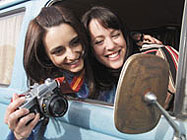|
|
|
|
Travelling Light
|
 |
|
Kathryn
Millard’s Travelling Light presents a
curious case study in contemporary Australian cinema.
As
a conventional story about fictional characters on a life-changing personal
journey, it simply does not work. But in its moment-to-moment detail of images,
sounds and observations, it has more substance than many local films.
The
plot is slight. It is 1971. Leanne and Bronwyn are sisters – although the
respective casting of Pia Miranda and Sacha Horler as siblings strains
credibility from the first look. Leanne is sick of her training to be a
teacher, while Bronwyn is trapped in a loveless marriage. Things pick up when
an American Beat poet, Lou (Brett Stiller), visits his wicked ways of sex,
drugs and rock’n’roll upon the sleepy community and especially a Bert
Newton-style TV variety show.
This
is a deliberately unsensational, unspectacular film, which some viewers will
find too tentative. Big story events, and all hints of sex or violence, are
discreetly kept off-screen. It ends with perhaps the worst feel-good, frolic
shot ever seen in Australian cinema. But it is on the levels of lighting,
choice of music tracks, and ways of framing the environment and its living
spaces that the film achieves its best and most subtle effects.
Adelaide’s suburbia, as presented
by Millard, is a hellish, ordered prison which historian Michel Foucault might
have relished describing in his book Discipline
and Punish. We are far beyond the
eerie, white picket fences and sickly sweet robins of Blue Velvet (1986) here. Soul-destroying boredom bespeaks a deep
repression, and social etiquette hides cruel rituals of control such as shock
therapy for unhappy housewives. The dominant tone of the film is melancholy
bordering on despair.
But
it is never easy to make stories of small town or suburban ennui credible –
especially in the modern era. Why don’t these whinging sisters just go to a
rock concert in the city centre? There is a similar air of vagueness that hangs
over many of the narrative details. For instance, why does the great celebrity
Lou hang around for so long in the philistine, stultifying environs of
Adelaide?
The
biggest problem, from a mainstream cinema perspective, is the conception of
Leanne’s character. She has no arc – she starts off as a
feisty, knowing lass, and ends up exactly the same way, just slightly
freer to do as she pleases. Bronwyn’s story is more compelling, and Horler
gives another fine performance that suggests the depths of her inner turmoil.
Travelling Light strikes me as an uneasy
compromise between the storytelling formula current in mainstream filmmaking
and an approach that harks back to the independent styles and approaches that
were once far more prevalent in Australia.
Whenever
Leanne picked up her camera and snapped either her naked mirror reflection or
her shadow on the grass, I remembered our proud, vibrant, experimental
tradition of women’s cinema. This voice just manages to sustain its note in Travelling Light, but it is worth attending
to.
MORE Australian women's independent cinema: Dreams for Life, Mamadrama, The Good Looker, Vacant Possession © Adrian Martin September 2003 |
![]()